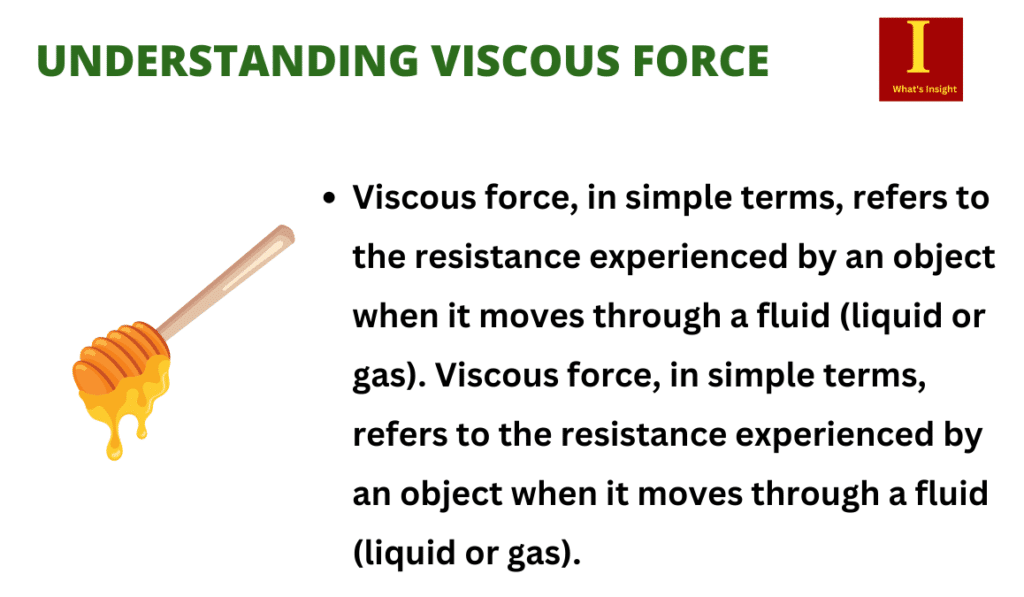Viscous force, in simple terms, refers to the resistance experienced by an object when it moves through a fluid (liquid or gas). This force is caused by the internal friction between different layers of the fluid. The formula to calculate viscous force is given by:
Viscous Force = Coefficient of Viscosity × Area × Velocity Gradient (Newton Units)
Table of Contents
Everyday Examples of Viscous Force
- Stirring honey in a cup: When you stir honey with a spoon, you can feel the resistance as the honey tries to stick to the spoon and moves sluggishly due to its high viscosity.
- Moving through water: When swimming, your body experiences resistance from the water, especially if you try to move quickly. This resistance is due to the viscous force of the water acting against your motion.
- Pouring syrup on pancakes: Syrup flows slowly and forms thick streams due to its high viscosity, making it take longer to spread on pancakes compared to a less viscous liquid like water.
- Oil dripping from a bottle: When you tip an oil bottle, the oil flows out slowly in drops because of its viscosity. The viscous force opposes the oil’s movement and causes it to fall in a controlled manner.
- Car moving through air: As a car moves through the air, it experiences air resistance, which is a type of viscous force. This resistance increases with speed and affects fuel efficiency.

Coefficient of viscosity in simple words
Coefficient of viscosity, in simple words, is a measure of how “thick” or “sticky” a fluid is. It quantifies the resistance of a fluid to flow or its internal friction. A high coefficient of viscosity indicates a thicker and more resistant fluid, while a low coefficient of viscosity suggests a thinner and more easily flowing fluid. It helps us understand how easily or difficultly a fluid, such as honey or oil, can flow or be poured. For instance:
- Water: Water has a relatively low coefficient of viscosity, which means it flows easily and quickly. It is often used as a reference fluid with a viscosity of 1 centipoise (cP) at room temperature.
- Honey: Honey has a higher coefficient of viscosity compared to water. It flows more slowly and is more resistant to pouring due to its thicker consistency.
- Motor Oil: Motor oil used in engines has a higher coefficient of viscosity to ensure proper lubrication. It needs to maintain a certain thickness to effectively coat engine parts and reduce friction.
- Ketchup: Ketchup has a higher coefficient of viscosity compared to water. It flows slowly and requires shaking or tapping the bottle to facilitate its movement.
Solved Numerical Problem
Viscosity of the oil is 0.05 Ns/m^2. If the ball bearing falls with a velocity of 0.2 m/s, calculate the viscous force acting on it.
Solution: Given: Radius of the ball bearing (r) = 2 cm = 0.02 m Coefficient of viscosity (η) = 0.05 Ns/m^2 Velocity of the ball bearing (v) = 0.2 m/s
We can calculate the viscous force using the formula:
Viscous Force = Coefficient of Viscosity × Area × Velocity Gradient
The area of the ball bearing can be calculated using the formula:
Area = π × r^2
Substituting the given values: Area = π × (0.02)^2 Area ≈ 0.00126 m^2
The velocity gradient is the rate of change of velocity with respect to the distance traveled. In this case, since the ball bearing is falling vertically, the velocity gradient is equal to the velocity divided by the height (h) at which the ball bearing falls.
The height is not given in the problem, so let’s assume the ball bearing falls through a height of 1 meter.
Velocity Gradient = Velocity / Height Velocity Gradient = 0.2 m/s / 1 m Velocity Gradient = 0.2 s^-1
Now we can calculate the viscous force:
Viscous Force = 0.05 Ns/m^2 × 0.00126 m^2 × 0.2 s^-1 Viscous Force ≈ 0.0000252 N
Therefore, the viscous force acting on the ball bearing is approximately 0.0000252 Newtons.
Summary-Viscous Force
- Resistance experienced when an object moves through a fluid.
- Caused by internal friction between fluid layers.
- Measured in Newtons (N).
- Calculated using the formula: Coefficient of Viscosity × Area × Velocity Gradient.
- Examples in daily life: stirring honey, swimming through water, pouring syrup, oil dripping, air resistance on a moving car.
- Coefficient of viscosity measures a fluid’s resistance to flow.
- Important in fluid dynamics, lubrication, and material processing.
More Links
Reynold’s Number Formula| Daily Life Examples
Dynamic Viscosity-Formula Derivation
Critical Velocity of Fluids| Daily Life Examples
What is Laminar Flow ?| Real Life Examples
Air Resistance: Definition, Types, and Factors Affecting
Frictional force| Definition and Daily Life Examples
- BCl3 Lewis Structure in four simple steps - November 1, 2023
- PH3 Lewis Structure in four simple steps - October 8, 2023
- PF3 Lewis structure in four simple steps - September 24, 2023



